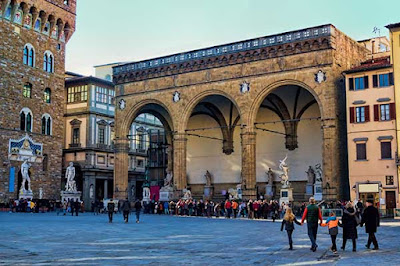In 1907 Edward Hutton began his tour of Florence by ascending the hill to San Miniato and viewing the city from the Piazzale Michelangelo. But then, he descended into the city and began with a discussion of the famous Piazza della Signoria. Then, as now, one of the great pleasures of visiting Italy is just watching the people.
In every ancient city of the world, cities that in themselves for the most part have been nations, one may find some spot holy or splendid that instantly evokes an image of that of which it is a symbol,--which sums up, as it were, in itself all the sanctity, beauty and splendour of her fame, in whose name there lives even yet something of the glory that is dead….
Something of this power of evocation may still be found in the Piazza della Signoria of Florence: all the love that founded the city, the beauty that has given her fame, the immense confusion that is her history, the hatred that has destroyed her, lingers yet in that strange and lovely place where Palazzo Vecchio stands like a violated fortress, where the Duke of Athens was expelled the city, where the Ciompi rose against the Ghibellines, where Jesus Christ was proclaimed King of the Florentines, where Savonarola was burned, and Alessandro de’ Medici made himself Duke.
It is not any great and regular space you come upon in the Piazza della Signoria…but one that is large enough for beauty, and full of the sweet variety of the city; it is the symbol of Florence—a beautiful symbol.
In the morning the whole Piazza is full of sunlight, and swarming with people: there is a stall for newspapers; here, a lemonade merchant dispenses his sweet drinks. Everyone is talking; at the corner of the Via Calzaioli a crowd has assembled, a crowd that moves and seems to dissolve, that constantly reforms itself without ever breaking up. On the benches of the loggia men lie asleep in the shadow, and children chase one another among the statues. Everywhere and from all directions cabs pass with much cracking of whips and hallooing. There stand two Carabinieri in their splendid uniforms, surveying this noisy world; an officer passes with his wife, leading his son by the hand; you may see him lift his sword as he steps on the pavement. A group of tourists go by, urged on by a gesticulating guide; he is about to show them the statues in the loggia; they halt under the Perseus….
And surely the Piazza, which has seen so many strange and splendid things, may well tolerate this also; it is so gay, so full of life. Very fair she seems under the sunlight, picturesque too, with her buildings so different and yet so harmonius. On the right the gracious beauty of the Loggia de’ Lanzi; then before you the lofty, fierce old Palazzo Vecchio; and beside it the fountains play in the farther Piazza. Cosimo I rides by as though into Siena, while behind him rises the palace of the Uguccioni, which Folfi made; and beside you the Calzaioli ebbs and flows with the noisy life, as of old the busiest street of the city.
 |
| Loggia de' Lanzi |
###
Edward Hutton: Florence and Northern Tuscany with Genoa, second edition, London, 1908. Pp. 161-2.



No comments:
Post a Comment